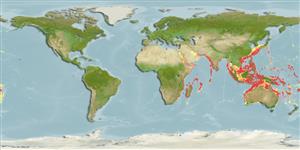Common names from other countries
Environment: milieu / climate zone / depth range / distribution range
Écologie
Récifal; profondeur 3 - 15 m (Ref. 8294). Tropical
Indo-West Pacific: West to Red Sea; north to Japan, east to Vanuatu; south to Australia.
Length at first maturity / Taille / Poids / Âge
Maturity: Lm ? range ? - ? cm Max length : 50.0 cm COLD mâle / non sexé; (Ref. 269)
Description synthétique
Morphologie
Colonies form mounds up to 50 cm in diameter that may dominate large patches of reef. The colonies are composed of thin tubes (the "organ pipes"), 0.2 cm diameter in length, cemented together by horizontal plates at intervals of several centimeters. In life, the corals have white polyps that may cover the corallum. The skeleton is deep red (Ref. 269).
Maximum depth from Ref. 123855. Abundant in mid-shelf reefs, becomes prolific at a depth of 20 m. Less common in muddy coastal areas (Ref. 101098). Common from the reef flat to intermediate depths (Ref. 296).
Life cycle and mating behavior
Maturité | Reproduction | Frai | Œufs | Fécondité | Larves
Members of the class Anthozoa are either gonochoric or hermaphroditic. Mature gametes are shed into the coelenteron and spawned through the mouth. Life cycle: The zygote develops into a planktonic planula larva. Metamorphosis begins with early morphogenesis of tentacles, septa and pharynx before larval settlement on the aboral end.
Ross, M.A. and G. Hodgson. 1981. (Ref. 8294)
Statut dans la liste rouge de l'IUCN (Ref. 130435)
statut CITES (Ref. 108899)
Not Evaluated
Utilisations par l'homme
Pêcheries: d'intérêt potentiel
| FishSource | Sea Around Us
Outils
Sources Internet
Estimates based on models
Preferred temperature
(Ref.
115969): 11.5 - 23.7, mean 17.4 (based on 629 cells).
Vulnérabilité
Moderate vulnerability (40 of 100).
Catégorie de prix
Unknown.
